Mad Hedge Biotech and Healthcare Letter
March 21, 2023
Fiat Lux
Featured Trade:
(A BUMP IN THE ROAD)
(SRPT), (BIIB), (VRTEX), (RHHBY)

Mad Hedge Biotech and Healthcare Letter
March 21, 2023
Fiat Lux
Featured Trade:
(A BUMP IN THE ROAD)
(SRPT), (BIIB), (VRTEX), (RHHBY)

Little Orphan Annie had already predicted it: “The sun will come out tomorrow.” While it is disheartening that we’re still in a bear market, stocks will bounce back eventually.
It looks like Wall Street overreacted once again following the change in leadership in the Food and Drug Administration earlier this month. Dr. Billy Dunn, the public face of the highly controversial accelerated approval granted to Biogen’s (BIIB) Alzheimer’s disease drug and the standard bearer of the organization’s push for more flexibility on drug approvals, retired.
Biotech investors have expressed anxiety over the possibility of facing more stringent rules in the drug approval process. The fear is that Dunn’s departure would signify a step toward a more conservative handling of applications.
While the FDA assured the public that the approval process would likely remain the same, some notable decisions are proving otherwise.
One of them involves Sarepta Therapeutics (SRPT).
Sarepta Therapeutics is a biopharmaceutical company that focuses on developing and commercializing RNA-targeted therapies for rare neuromuscular diseases. Founded in 1980, this Cambridge-based company’s most notable drug is Exondys 51 (eteplirsen), used to treat Duchenne muscular dystrophy (DMD), a rare genetic disorder affecting muscle function.
Exondys 51 is designed to skip over a faulty section of the dystrophin gene, which helps to produce a functional protein that can slow the progression of the disease. Sarepta is also developing RNA-targeted therapies for rare diseases, such as limb-girdle muscular dystrophy and myotonic dystrophy. Since then, the company has earned additional approvals for Vyondys 53 and Amondys 45.
Basically, Sarepta is to DMD as Vertex Pharmaceuticals (VRTX) is to cystic fibrosis—both have virtual monopolies in their target markets.
Recently, though, Sarepta stock has started to fall. This came after the FDA announced its plan to seek additional input from a panel of independent experts regarding the company’s new DMD gene-therapy candidate: SRP-9001.
The move came as a surprise since Sarepta disclosed only a week or so ago that the FDA had no intention to convene an advisory board to evaluate the candidate. However, since SRP-9001 is one of the first-ever gene therapies biologics license applications built on a surrogate perspective, meaning it’s an alternative to clinical results, the FDA felt the need to add a layer of review.
Still, the fall in Sarepta’s share prices appeared to be yet another overreaction. Besides, the move was not triggered by any issue with the candidate or data from the trials. It was simply a precautionary measure. Despite the slight detour, Sarepta remains optimistic that it will receive the go signal for SRP-9001 by May 2023.
Prior to this, Sarepta shares have been beating the market since 2023 started and have recorded more than double increases in the last five years. Although the company does not enjoy the same name recall as several of its peers, Sarepta’s platform of promising and innovative treatments has delivered critical wins in the past, especially in the DMD market.
On top of its DMD-centered products, Sarepta has over 40 clinical programs. That’s impressive for a biotech with an $11 billion market capitalization.
More importantly, the latest catalyst for Sarepta, SRP-9001, is projected to become another blockbuster. This Roche-partnered (RHHBY) treatment is estimated to generate more than $4 billion in peak sales.
Notably, this particular DMD indication has been shown to exhibit an extremely high barrier to entry, with practically all experimental treatments falling apart in clinical trials. Needless to say, SRP-9001 would have an exceedingly high commercial ceiling plus a built-in competitive moat.
Investors can expect remarkable progress from Sarepta as a company and its programs in the next five years. Given the company’s track record and history, it won’t be farfetched for it to come up with more blockbusters soon.
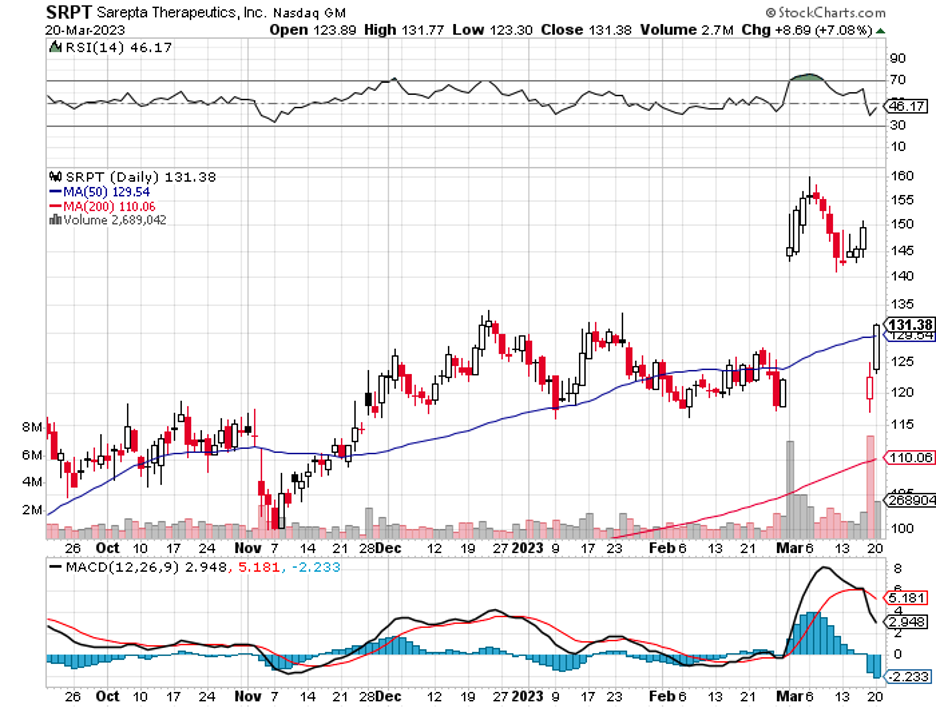
Mad Hedge Biotech and Healthcare Letter
August 4, 2022
Fiat Lux
Featured Trade:
(A SELLOFF SURVIVOR READY FOR MORE GAINS)
(PFE), (SRPT), (PTCT), (GSK), (JNJ), (MRNA)

The broader market hasn’t been putting that much faith in drugmakers these days, and this could very well be a mistake.
While 2022 has not been particularly kind to equities recently, several names in the biotechnology and healthcare sector still managed to keep themselves safe from the selloff.
Pfizer (PFE), with its COVID vaccine sales, is one of them. Admittedly, this pharmaceutical giant has not shown substantial growth in the past monthS. Nonetheless, its quarterly updates and, more importantly, pipeline have exhibited notably encouraging signals.
As a massive underperformed in the past 20 years, Pfizer has taken aggressive steps to transform its strategy. The most obvious way to shake up the business is to eliminate the bulk of its noncore products.
However, it’s not advisable to buy a company just because it has been underperforming and would then be sold at lower prices. Instead, it is critical to determine whether there’s a catalyst.
For Pfizer, the catalyst was clear: COVID.
The company was and still is at the heart of the coronavirus vaccine drives and treatments—a position that’s projected to be sustained for years to come.
The company has made a fortune from this program, and it’s still reaping the rewards in a massive way.
In the second quarter of 2022, Pfizer’s revenue climbed by 53% year-over-year to reach $27.7 billion. Based on the company’s record, this is the most significant quarterly sales during this period to date.
For context, its COVID vaccine, Comirnaty, raised $8.8 billion in sales. This is 20% higher than its reported sales in 2021 over the same period.
Meanwhile, Pfizer’s new COVID therapy, Paxlovid, recorded $8.1 billion in sales. Taken together, Paxlovid and Comirnaty comprise over half of the company’s total revenue for the second quarter.
Leveraging these growth opportunities, Pfizer has been steadily expanding its pipeline.
To date, the company has roughly 96 drugs in its pipeline. Of these, 6 drugs are in registration, while 29 candidates are queued for Phase 3 trials. There are 31 drugs in Phase 2 and 30 more in Phase 1.
Pfizer’s candidates range from treatments for inflammation, immunology, oncology, vaccines, and internal medicine to rare disease therapies.
Among the treatments in its Phase 3 study, two have been identified to bring in billions of dollars for Pfizer potentially.
One is PF-06939926, which is a treatment for Duchenne syndrome. The other is PF-06928316, which is for Respiratory Syncytial Virus (RSV).
Globally, 1 in 3,500 to 5,000 males suffer from Duchenne syndrome. This puts the number of patients at roughly 250,000, with about 10,000 to 15,000 found in the US. While it generally affects males, it can sometimes affect females as well.
In terms of market size, the Duchenne syndrome market is expected to be worth $4 billion in 2023 and $7 billion by 2027.
Currently, the major approved treatments for this condition are Sarepta's (SRPT) Exondys 51, Vyondys, and Amondys, as well as PTC Therapeutics (PTCT) Emflaza and Translarna.
PTC recorded $236 million in sales for Translarna, which is approved in Europe, and $187 million for Emflaza, approved in the US, for a total of $423 million in sales in 2021. Meanwhile, Sarepta’s overall sales reached $612 million for that same period.
Adding the rest of the minor competitors for Duchenne syndrome treatments, only $1.5 billion of the projected market value is held by the existing drugs. Clearly, there’s a lot of room for more companies to join the fray.
Meanwhile, RSV presents another lucrative market. According to the Centers for Disease Control and Prevention, this condition causes approximately 58,000 hospitalizations annually in the US.
Of these, 100 to 500 deaths are children under 5 years old and 14,000 are adults aged 65 and above. The average expense in managing adult patients alone has reached roughly $3 billion every year.
In terms of market value, the RSV market is projected to reach $4 billion by 2027. So far, the biggest competitors in this space are GlaxoSmithKline (GSK), Johnson & Johnson (JNJ), and Moderna (MRNA).
While its rivals are challenging, Pfizer still estimates sales for its RSV vaccine to reach at least $1.5 billion annually.
Thanks to its COVID programs, Pfizer has been hailed as the undisputed leader of the pack in terms of reputation and credibility in research.
Needless to say, these factors would serve as a valuable growth lever for the healthcare giant for decades.
As one of the largest biopharmas in the world, Pfizer has established a reputation for outstanding innovation. Over the years, the company has delivered several revolutionary treatments to the market like Viagra or Lyrica.
Simultaneously, it developed Lipitor, reaching $14.5 billion in sales over 14.5 years.
Since then, it has become a highly reputable industry name. Its diverse and extensive pipeline demonstrates that it remains a company highly capable of innovating and maintaining its dominance.
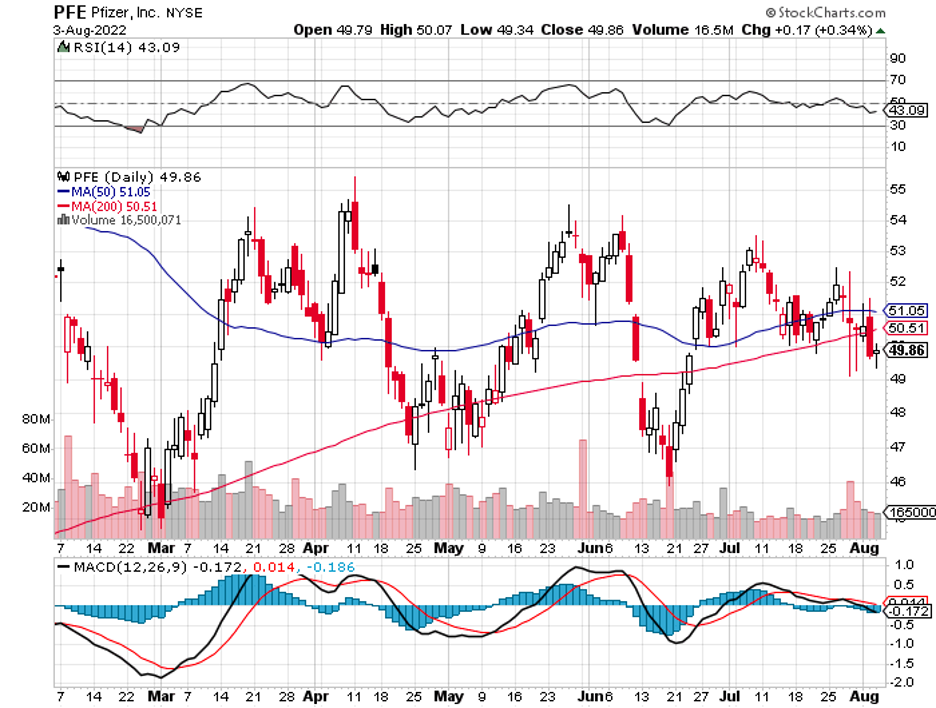
Mad Hedge Biotech & Healthcare Letter
September 9, 2021
Fiat Lux
FEATURED TRADE:
(A STOCK FOR BARGAIN HUNTERS)
(SRPT), (MRNA), (BNTX), (FGEN), (ACAD), (RARE), (BLUE), (CRSP), (PFE)

Biotechnology stocks that have fallen by over half since 2021 started are strewn around in the market.
While the share prices of COVID-19 stocks, such as Moderna (MRNA) and BioNTech (BNTX), have skyrocketed, the others in the sector are not as fortunate.
The biotechnology segment has been filled with relative horror stories from previous favorites like FibroGen (FGEN), Acadia Pharmaceuticals (ACAD), and Ultragenyx Pharmaceutical (RARE).
Among the companies hit with disappointing news, the gene therapy sector, which has stocks like bluebird bio (BLUE) and CRISPR Therapeutics (CRSP), appears to be having a tougher time than most.
So, where does this situation leave investors? Where should we look for value?
One tactic that would help value investors take advantage of this abysmal situation is studying Wall Street analysts' moves.
Look at target prices they set for the stocks they cover and then choose the companies trading the farthest below the expected price points.
Among the biotechnology stocks struggling these days, one of the names that emerged as a truly promising investment is Sarepta Therapeutics (SRPT).
To say that Sarepta has been experiencing a disappointing year is an understatement. Shares of this company have gone on a 57% heart-stopping plunge since 2021 started.
In fact, this biotech’s nosedive is the third-worst in the midcap or larger stock sector based on the two key exchange-traded funds: iShares Biotechnology ETF (IBB) and SPDR S&P Biotech ETF (XBI).
Despite Sarepta’s abysmal performance, Wall Street still labels the stock a buy.
Sarepta’s decline started in early January when the trial results for its gene therapy for Duchenne muscular dystrophy (DMD) failed to impress investors.
However, the subsequent trial for the same gene therapy, dubbed as SRP-9001, is anticipated to yield better results.
Although the results are expected to be released by late 2022 or early 2023, holding the stock for now is estimated to deliver remarkable profits for patient investors.
At this point, Sarepta stock is trading at roughly $80 per share.
However, experts predict that the next results for SRP-9001 would push the shares to climb to over $200.
DMD, which is a rare degenerative condition characterized by gradual weakening of the muscles, affects about 16,840 people in the US.
So far, the US FDA has only approved a handful of treatments for DMD—three of which are RNA-based drugs developed by Sarepta.
Evidently, the company has a firm grasp of the condition and a proven track record of launching and marketing DMD-centered products.
More importantly, this makes Sarepta a dominant—if not the most dominant—force in the DMD market.
What makes their newest treatment, SRP-9001, different is that it works on DNA. Despite the extended timeline, Sarepta’s candidate remains the frontrunner in this endeavor.
Its closest threat is PF-06939926, an investigational drug from Pfizer (PFE) that uses the same technology as SRP-9001.
At the very least, this competitor is two years away from producing any tangible result.
By the time Pfizer reaches Phase 3, Sarepta’s SRP-9001 has already generated roughly $1 billion in sales.
Apart from the three approved drugs, Sarepta still has 34 drug development programs focused on two niches: RNA and AVV gene therapies. Among them, 7 are already in the clinical stage, including SRP-9001.
If successful, the company will reach $1 billion in revenues by 2023.
Another reason that makes Sarepta an attractive opportunity is its notably intact cash flow backbone—an achievement that’s worth pointing out considering its underwhelming SRP-9001 results.
The company also has an impressive history.
Sarepta has blossomed from its humble beginnings working as a contractor for the Department of Defense on the Ebola virus. Since then, it has developed its pipeline through acquisitions and launching effective treatments for rare diseases.
While Sarepta’s treatments are effective, they cannot cure DMD. They can only slow its progression.
This means continuous and life-long use among patients. For context, one treatment costs an average of $300,000 per patient annually.
Although it lost over 50% of its value, Sarepta still has enough capacity to rebound soon.
The factors that would help the company achieve this include the strong lineup of products generating solid and predictable revenues as well as its promising pipeline.
More importantly, its struggles with SRP-9001 don’t seem enough for the company to scrap the project altogether.
If anything, it proved that Sarepta can explore more potent treatments for DMD by looking into RNA technology—a path that the likes of Moderna and BioNTech have already found success in.
Overall, I think Sarepta still has a lot left in the tank. It operates in one of the most exciting sectors.
It’s worth bearing in mind that the biotech sector is ripe with innovation from companies with the ability to conjure up life-changing treatments—a value perceived as a crucial hallmark for massive gains.
Needless to say, Sarepta’s achievements in the DMD sector and its growth trajectory make it a shoo-in in this category.
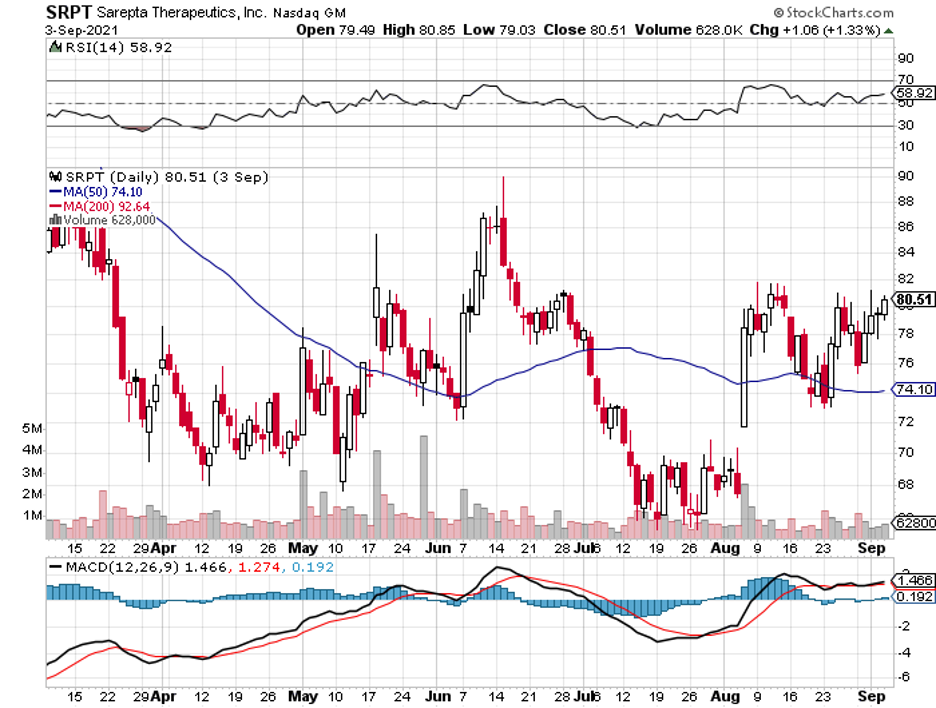
Mad Hedge Biotech & Healthcare Letter
August 19, 2021
Fiat Lux
FEATURED TRADE:
A LOW-PROFILE BIOTECH WINNER
(VRTX), (ACAD), (SRPT), (FGEN), (MRK), (MRNA), (NVS), (XLRN), (PTGX), (IONS), (BLUE), (EDIT), (ABBV)

Choosing winners among biotechnology and healthcare stocks these days isn’t easy.
Since the year started, the sector has been marred with several unexpected disappointments like the 50% decline of crowd favorites Acadia Pharmaceuticals (ACAD) and Sarepta Therapeutics as well as the 33% fall of the ever-dependable FibroGen (FGEN).
So, how can investors pick a winner?
One tactic is taking a peek at what Wall Street analysts are doing, noting which among the companies they’re following are trading the farthest below the estimated price points.
Among the names on the list, a particular stock stands out as a strong contender these days: Vertex Pharmaceuticals (VRTX).
Although it’s one of the most widely known biotechnology companies today, Vertex actually started in a garage of a Harvard-trained chemist, Joshua Bogner, who left his cushy job at one of the most illustrious big pharma companies at that time, Merck (MRK), to pursue his vision.
The company’s raison d’être was a major selling point for a lot of talented and idealistic scientists in that era.
That is, Vertex wanted to find cures for the most challenging diseases and do this in an unbureaucratic setting.
Since then, Vertex’s goal has been straightforward: tackle the most complex and toughest diseases and deliver breakthrough treatments that offer tangible benefits to patients.
Over the years, the company has managed to keep this goal at the forefront of its efforts, starting with its work on the devastating genetic disorder called cystic fibrosis (CF).
Vertex’s work on CF took over a decade, but it eventually led to an impressive franchise that helped with the treatment of patients.
In the first quarter of 2021 alone, sales in this segment reached $1.7 billion.
Expanding on its work, Vertex has explored genetic therapies and set up a collaboration with Moderna (MRNA) in 2016.
Using the latter’s well-established expertise in messenger RNA technology, the companies are expected to come up with more aggressive and advanced CF treatments in the coming years.
Given these developments, Vertex reiterated its 2021 sales guidance to be somewhere in the range of $6.7 and $6.9 billion. Meanwhile, sales of its CF franchise are estimated to peak at $9 to $10 billion—if not higher—by 2024.
Aside from its work on CF, Vertex has also been pouring resources on developing treatments for severe sickle cell anemia and beta thalassemia, a rare blood disorder.
In fact, the company has been looking into these developments as the next major revenue stream, as seen in its bolstered collaboration deal with CRISPR Therapeutics (CRSP).
In this deal, Vertex paid the smaller biotechnology company $900 million upfront plus a potential addition of $200 million following the first regulatory approval of their therapy, CTX001.
While this may sound like a hefty deal to some, Vertex actually values CTX001 at roughly $11 billion.
CTX001, which is a one-time therapy, is priced at roughly $1 million per patient. At this point, the market for beta thalassemia is valued at $32 billion.
Needless to say, this would make CTX001 a massive income generator in the next few years.
Considering the lucrative market for beta thalassemia, though, it’s no surprise that several competitors have emerged to grab their share as well.
Some companies, such as Novartis (NVS) and Acceleron (XLRN), offer maintenance drugs for the disease.
Meanwhile, others like Protagonist Therapeutics (PTGX) and Ionis Pharmaceuticals (IONS) are attempting to develop treatments that would become direct competitors of CTX001.
However, the closest rivals of the Vertex-CRISPR candidate are from Bluebird Bio (BLUE) and Editas Medicine (EDIT).
While this has become a crowded space, Vertex and CRISPR remain the leaders in this segment, as most of the other candidates are still in the investigation phase.
Since it was founded in the 1980s, Vertex has remained true to its vision of tackling some of the toughest diseases out there.
While big pharmaceutical companies, such as AbbVie (ABBV), decided to expand their portfolio through acquisitions, Vertex leveraged its talent pool and maximized its funds by establishing strategic collaborations instead.
This tactic provided the company with enough elbow room that eventually led to its dominance in the CF space, where it now enjoys a virtual monopoly until at least the next decade.
Meanwhile, it has forged strong relationships with promising biotechnology companies and can very well be on its way to becoming the most dominant force in the rare blood disorder segment.
Overall, Vertex Pharmaceuticals is an attractive stock with an impressive portfolio and an even more impressive pipeline.
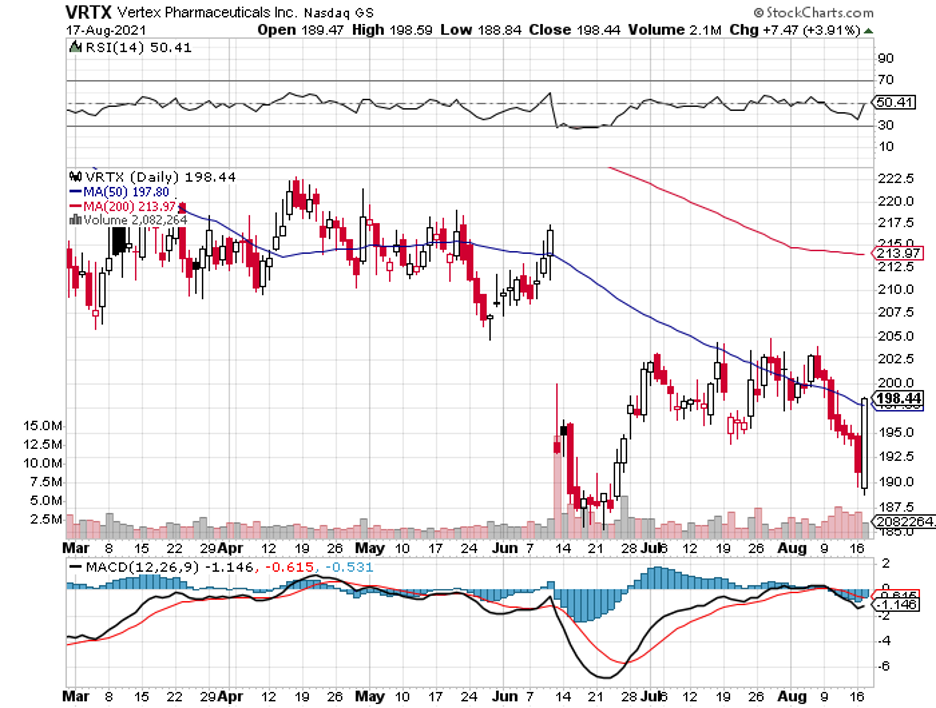
Mad Hedge Biotech & Healthcare Letter
June 8, 2021
Fiat Lux
FEATURED TRADE:
(THE BIGGEST NEWS IN BIOTECH TODAY)
(BIIB), (ESALY), (LLY), (RHHBY), (DNLI), (SRPT), (IONS), (ICPT), (SAVA), (ANVS), (CI), (CVS)

It’s not typical for stock market news to alter the lives of millions of people across the globe, but this is what Biogen (BIIB) managed to accomplish this week.
The company received accelerated approval from the US Food and Drug Administration (FDA) for its controversial Alzheimer’s disease treatment, Aducanumab.
The drug, which is now marketed as Aduhelm, marks a potential breakthrough medication for over 6 million Americans suffering from the debilitating illness and to possibly billions all worldwide.
Basically, Aduhelm targets what Biogen calls “a defining pathology of the disease” by decreasing the amyloid beta plaque levels in the brains of patients suffering from Alzheimer’s disease.
Biogen shares spiked by roughly 60% following the Aduhelm news, with the pop in the biotechnology stock even more impressive than what was initially predicted.
This latest FDA approval also brings a ray of hope for the biotechnology industry.
Biotech shares have been in a slump this year, with the SPDR S&P Biotech ETF (XBI) falling by 9.2% thus far.
Potential second-order effects of the Biogen win can easily be seen in other developers of Alzheimer’s disease treatments.
Although the moves may not be as dramatic as Biogen’s, several biotech companies benefited from the good news.
Directly benefiting from it is Japanese drugmaker Eisai (ESALY), which has been working with Biogen on Alzheimer’s disease treatment. This company’s American depository receipts climbed by 48.2% after the news broke.
Eli Lilly (LLY), which is also working on its own Alzheimer’s therapy, saw its shares go up 9.3%.
Even Roche (RHHBY), which is still in the early stages of its development of a similar treatment, enjoyed a 1.6% increase, while an under-the-radar biotech company, Denali Therapeutics (DNLI), experienced a 7.8% increase.
Other smaller companies that benefited from Biogen’s news include Sarepta Therapeutics (SRPT), Ionis Pharmaceuticals (IONS), Intercept Pharmaceuticals (ICPT), Cassava Sciences (SAVA), and Annovis Bio (ANVS).
In terms of pricing, Aduhelm is estimated to cost $56,000 per year.
Although there is still no definite number in terms of how much Aduhelm could generate in sales for the company, there have been early estimates prior to this news.
Before this accelerated approval, Aduhelm was projected to add at least $16 billion in market capitalization to Biogen.
If successful, the drug can contribute a minimum of $10 billion in sales annually—a performance that would make Aduhelm one of the best-selling drugs of all time.
At this price point as well, the drug could peak at $5.7 billion by 2027.
Understanding that the cost is too high for some, Biogen has been working on establishing partnerships with healthcare and insurance companies to help patients cover the expenses.
So far, Biogen has been negotiating with Cigna (CI) to come up with terms to make Aduhelm available to Alzheimer’s patients via a value-based contract.
That is, the pricing will be assessed based on how responsive the patient will be to the treatment.
Biogen has also been working on collaborating with CVS Health (CVS) to develop more efficient ways to implement cognitive screenings in urban markets.
The two companies have been looking into boosting testing within underserved communities to improve early diagnosis, with the project commencing by September.
Some cities included in this initiative are Washington, D.C., Los Angeles, Dallas, Chicago, South Carolina, Atlanta, New York, Detroit, and Philadelphia.
Biogen has finally regained its momentum thanks to this accelerated and unprecedented approval.
That means we can expect Biogen to leverage this massive revenue stream to round out the rest of its programs and boost its R&D, as well as possibly compensating its shareholders with share buybacks and even dividends in the second half of this decade.
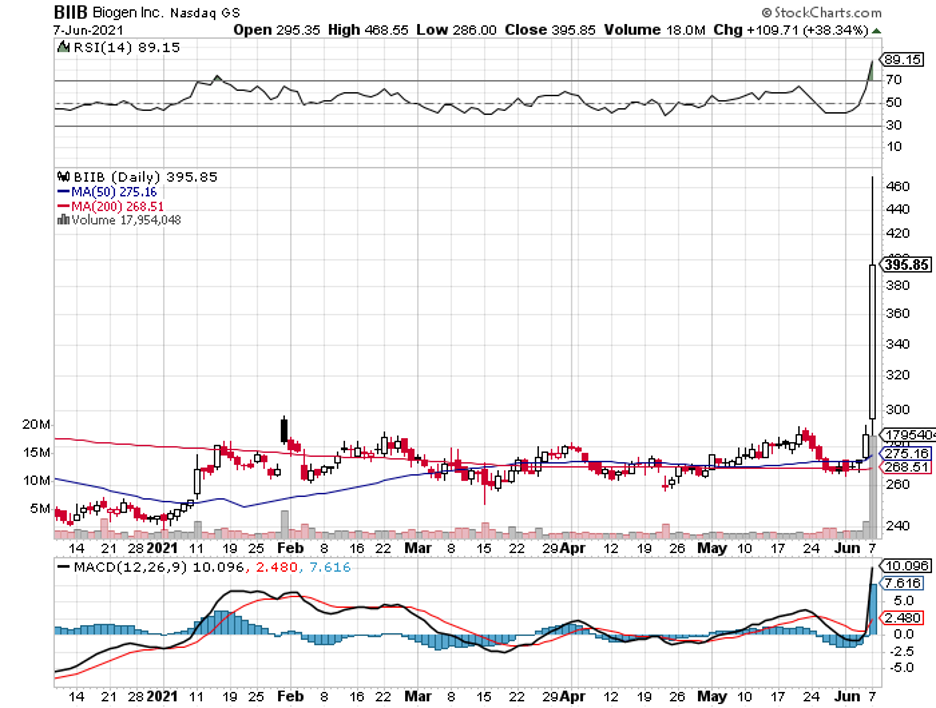
Legal Disclaimer
There is a very high degree of risk involved in trading. Past results are not indicative of future returns. MadHedgeFundTrader.com and all individuals affiliated with this site assume no responsibilities for your trading and investment results. The indicators, strategies, columns, articles and all other features are for educational purposes only and should not be construed as investment advice. Information for futures trading observations are obtained from sources believed to be reliable, but we do not warrant its completeness or accuracy, or warrant any results from the use of the information. Your use of the trading observations is entirely at your own risk and it is your sole responsibility to evaluate the accuracy, completeness and usefulness of the information. You must assess the risk of any trade with your broker and make your own independent decisions regarding any securities mentioned herein. Affiliates of MadHedgeFundTrader.com may have a position or effect transactions in the securities described herein (or options thereon) and/or otherwise employ trading strategies that may be consistent or inconsistent with the provided strategies.
This site uses cookies. By continuing to browse the site, you are agreeing to our use of cookies.
OKLearn moreWe may request cookies to be set on your device. We use cookies to let us know when you visit our websites, how you interact with us, to enrich your user experience, and to customize your relationship with our website.
Click on the different category headings to find out more. You can also change some of your preferences. Note that blocking some types of cookies may impact your experience on our websites and the services we are able to offer.
These cookies are strictly necessary to provide you with services available through our website and to use some of its features.
Because these cookies are strictly necessary to deliver the website, refuseing them will have impact how our site functions. You always can block or delete cookies by changing your browser settings and force blocking all cookies on this website. But this will always prompt you to accept/refuse cookies when revisiting our site.
We fully respect if you want to refuse cookies but to avoid asking you again and again kindly allow us to store a cookie for that. You are free to opt out any time or opt in for other cookies to get a better experience. If you refuse cookies we will remove all set cookies in our domain.
We provide you with a list of stored cookies on your computer in our domain so you can check what we stored. Due to security reasons we are not able to show or modify cookies from other domains. You can check these in your browser security settings.
These cookies collect information that is used either in aggregate form to help us understand how our website is being used or how effective our marketing campaigns are, or to help us customize our website and application for you in order to enhance your experience.
If you do not want that we track your visist to our site you can disable tracking in your browser here:
We also use different external services like Google Webfonts, Google Maps, and external Video providers. Since these providers may collect personal data like your IP address we allow you to block them here. Please be aware that this might heavily reduce the functionality and appearance of our site. Changes will take effect once you reload the page.
Google Webfont Settings:
Google Map Settings:
Vimeo and Youtube video embeds:
